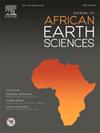Lower detrital and intermediate marine series of Oued Rhiou (Lower Chelif Basin, Algeria): biostratigraphic calibration, paleoenvironment dynamics and climate near the Burdigalian-Langhian boundary
IF 2.2
4区 地球科学
Q2 GEOSCIENCES, MULTIDISCIPLINARY
引用次数: 0
Abstract
Early and Middle Miocene microfossil-rich sediments have allowed better biostratigraphy of the Oued Rhiou geological series (southern margin of Lower Chelif Basin). Calibration between Calcareous nannoplankton (Helicosphaera ampliaperta, Sphenolithus heteromorphus) and Planktonic foraminifera (Globigerinoides trilobus, Gs. sicanus without Praeorbulina) biozone markers of the Oued Taberket and Sidi El Rhorb sections corresponds to the latest Burdigalian. The Oued Boutelis Langhian age is based upon Globorotalia siakensis, Praeorbulina glomerosa curva and P. glomerosa glomerosa, associated with S. heteromorphus, H. ampliaperta and ostracods. Through successive biozones (upper N9/NN4 to lower N10), this last section reaches late Langhian, which includes the Burdigalian-Langhian boundary (biozones N8/NN4). This boundary correlates well with the generally accepted one (15.974 Ma). A large subsidence furrow in the SW piedmont of the Ouarsenis is responsible for this sedimentation. The process of its filling during the latest Burdigalian to late Langhian is characterized by transgressive-regressive sequences correlated with the fluctuations of the eustatic cycles TB2.3 and TB2.4. These illustrate three marine sedimentation phases separated by two discontinuities: intra-latest Burdigalian and Burdigalian-Langhian boundary. The first (deep) phase tends towards a coastal detritic environment, the second being coastal sub-to mid-littoral high-energy detritic, illustrating a clear eustatic and tectonic evolution, evidence of significant subsidence. A hyperpycnal delta initiated the third phase, evolving gradually into a deep environment. The characteristics of the paleontological environment indicate warm climatic conditions during the latest Burdigalian to Langhian in the northern Algerian basins, admitting mangroves on the coasts. These thermal conditions suggest the same characteristics of the mid-Miocene climatic optimum.
阿尔及利亚下切里夫盆地Oued Rhiou下部碎屑和中间海相系列:布迪加里亚-朗吉安边界附近的生物地层定标、古环境动力学和气候
早中新世和中中新世微化石丰富的沉积物为下切里夫盆地南缘Oued Rhiou地质系列提供了较好的生物地层条件。钙质纳米浮游生物(Helicosphaera ampliaperta, Sphenolithus heteromorphus)与浮游有孔虫(gloigerinoides trilobus, Gs.)的校正。Oued Taberket和Sidi El Rhorb剖面的生物区标记对应于最新的Burdigalian。Oued Boutelis Langhian年龄是基于Globorotalia siakensis, Praeorbulina glomerosa curva和P. glomerosa glomerosa,与S. heteromorphus, H. ampliaperta和介形虫相关。通过连续的生物带(上部N9/NN4至下部N10),最后一段到达朗喜晚期,包括burdigian -Langhian边界(生物带N8/NN4)。该边界与普遍接受的边界(15.974 Ma)吻合良好。瓦塞尼斯山脉西南山前的一个大下沉沟是造成这种沉积的原因。在布尔迪加世晚期至朗吉世晚期,其充填过程具有与TB2.3和TB2.4上升旋回波动相关的海侵-海退序列特征。这说明了由两个不连续面分隔的三个海相沉积阶段:最新的布尔迪加里亚和布尔迪加里亚-朗吉安边界。第一期(深部)趋向于海岸碎屑环境,第二期为沿海亚—中海岸高能碎屑环境,表现出明显的沉降和构造演化特征。第三阶段由高旋角三角洲开始,逐渐演化为深部环境。古生物环境特征表明,在阿尔及利亚盆地北部的burdigian至Langhian晚期,温暖的气候条件允许红树林在海岸生长。这些热条件显示了中新世中期气候最佳的相同特征。
本文章由计算机程序翻译,如有差异,请以英文原文为准。
求助全文
约1分钟内获得全文
求助全文
来源期刊

Journal of African Earth Sciences
地学-地球科学综合
CiteScore
4.70
自引率
4.30%
发文量
240
审稿时长
12 months
期刊介绍:
The Journal of African Earth Sciences sees itself as the prime geological journal for all aspects of the Earth Sciences about the African plate. Papers dealing with peripheral areas are welcome if they demonstrate a tight link with Africa.
The Journal publishes high quality, peer-reviewed scientific papers. It is devoted primarily to research papers but short communications relating to new developments of broad interest, reviews and book reviews will also be considered. Papers must have international appeal and should present work of more regional than local significance and dealing with well identified and justified scientific questions. Specialised technical papers, analytical or exploration reports must be avoided. Papers on applied geology should preferably be linked to such core disciplines and must be addressed to a more general geoscientific audience.
 求助内容:
求助内容: 应助结果提醒方式:
应助结果提醒方式:


